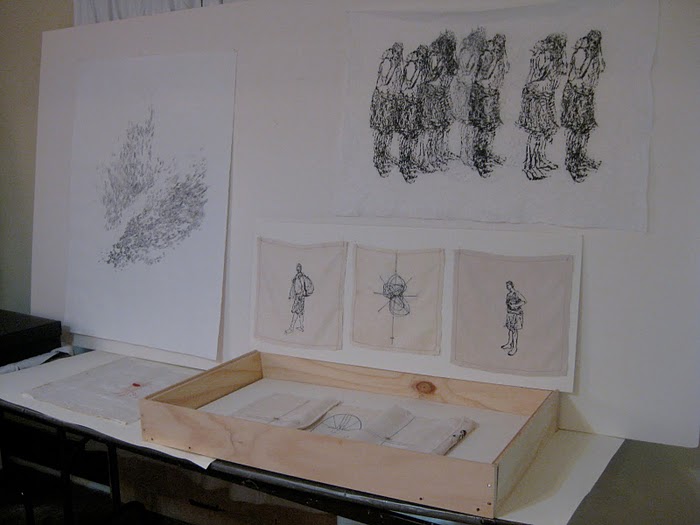
Hadar Sobol at her Studio in Salina, TX
A stitch just in time...embroidery is not an art usually associated with gritty self expression, but artist Hadar Sobol's embroideries on vintage linens and on paper are full of jagged emotion. From a few feet away, it's easy to mistake them for pen and ink sketches. Up close, there's no doubt about it, Israeli-born Sobol has command of her needle and thread as if her life might depend on it.
Because in a way, it does.
I started following Sobol's work a little more than year ago, after being invited to visit her home in Plano and later her studio in Salina, TX, where she had been working to prepare for her first one-person show at Valley House Gallery. Her show, Kairos (the Supreme Moment), opened on Saturday and runs through October 2.
 Sobol, who is from Tel Aviv, moved to Plano almost 10 years ago with her husband who was transferred with his job. Pregnant with her first child (she now has two) and struggling with the English language, Sobol became increasingly isolated. Art became the way out and the way to survive, and she started expressing herself through a medium she was most familiar and comfortable with -- embroidery. Those simple black stitches pack a lot of power.
Sobol, who is from Tel Aviv, moved to Plano almost 10 years ago with her husband who was transferred with his job. Pregnant with her first child (she now has two) and struggling with the English language, Sobol became increasingly isolated. Art became the way out and the way to survive, and she started expressing herself through a medium she was most familiar and comfortable with -- embroidery. Those simple black stitches pack a lot of power.The themes in her work focus on the burdens women carry throughout life -- from bearing children to obsessions with body image, especially as we age.
"My work draws its inspiration from the narrative of a woman's inner voyage," Sobol says in a statement that accompanies her work. "During this voyage, as she confronts the changes in her life, she finds that in addition to experiencing pain she is provided with the opportunity to recreate herself."

Embroidery on vintage cloth by Hadar Sobol
At left, the moving book by Ukranian-born Israeli writer Alona Kimhi that helped inspire Sobol's first forays into art. Weeping Susannah is the story of a woman's struggle to learn to express herself, to live, and to love. Sobol has her own story, and it's expressed in her art. At right, the tiny farmhouse in Salina that Sobol converted into her studio.
 "These images are transformed by the use of the reverse side of the embroidered cloth, digital manipulations and moving between different techniques, drawing, embroidery, etching, digital processing, and computerized embroidery," Sobol says.
"These images are transformed by the use of the reverse side of the embroidered cloth, digital manipulations and moving between different techniques, drawing, embroidery, etching, digital processing, and computerized embroidery," Sobol says. The works above and below were created by digitally reproducing the reversed, unfinished side of the embroidered cloth onto paper, then washing it with ink and water.
Sobol sometimes embroiders onto the paper itself.

This is a collage of photos I took from Sobol's house and also her studio, months before her show. She displayed her work for visitors by setting up a half dozen or so ironing boards, which she liked for their flat surfaces. It was an expedient choice, she said, but so full of unintended irony -- what better way to show embroidery on linen, especially when the subject matter has to do with women's work?
 At left, Valley House Gallery owner Cheryl Vogel, who made regular pilgrimages to Sobol's house and studio during the past year as the artist prepared for her show. I was privileged to tag along on two of these trips, and impressed by the way Cheryl and husband Kevin Vogel nurture their artists' careers. Kevin's father Donald Vogel founded Valley House Gallery in the late 1950s.
At left, Valley House Gallery owner Cheryl Vogel, who made regular pilgrimages to Sobol's house and studio during the past year as the artist prepared for her show. I was privileged to tag along on two of these trips, and impressed by the way Cheryl and husband Kevin Vogel nurture their artists' careers. Kevin's father Donald Vogel founded Valley House Gallery in the late 1950s."Some artists come to us with their whole body of work already completed and all we have to do is build a show around it," Cheryl says. "Others, like Hadar, we have more of a chance to work with and follow along. It's really a wonderful opportunity to get to be with them from the beginning." Pictured at right in the white coat is Liliana Bloch, director of the McKinney Avenue Contemporary.
Sobol also produces original videos to accompany certain pieces, which she plays via a digital picture frame underneath embroidered vintage linens.



The videos are beautiful works of art, blurred and mysterious depictions of nude women who are obsessively fussing over their lumpy, misshapen bodies. Sobol's models were wearing panty hose, which they stuffed with wads of cloth until their hips, bottoms, and stomachs, looked huge. It's all shot and viewed as if behind a veil, maybe as if we are peeking from behind a curtain, as the models attempt to arrange and rearrange their bodies, their burdens.
Sobol gives an artist's talk on Saturday, September 11 at 11:00 a.m at the gallery.










